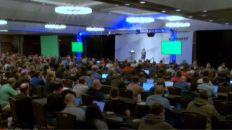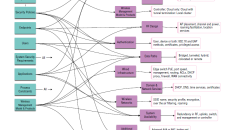This article by Jennifer Minella originally appeared in Network Computing.
Wireless networking presents a unique set of challenges that have to be overcome to get information from point A to point B. Most of the quirkiness of wireless technologies has to do with the controls put in place to allow it to operate over the physical medium of the air. From collision avoidance to time slicing and even data rates, the functions and characteristics of wireless success (and failure) can most often be traced to the challenges of communicating over the air.
This series starts with an overview of wireless’s most often-overlooked but fundamental elements: the properties of RF and waves.
RF and Waves
Wireless networking is an RF (radio frequency) technology. Air is the vehicle through which the data is carried, just as Ethernet uses copper cables. WLAN frequency ranges are in the 2.4GHz and 5GHZ bands. The most common legacy wireless standards, 802.11b and 802.11g, use the 2.4GHz range. IEEE 802.11a uses 5GHz exclusively. The newer 802.11n operates mostly in 5GHz but can also use the 2.4GHz band. The forthcoming 802.11ac standard operates in 5GHz.
To give you a visual, 2.4GHz waves are about 5 inches long. 5GHz waves are approximately double the frequency, and therefore half the length, about 2.5 inches.
The size of these WLAN waves isn’t just fodder for good water cooler trivia. As we all learned in middle school, the higher the wireless frequency is, the more compact the RF wave will be. The size of a wave has a significant effect on how it moves through the air, what it bounces off of, what will cause it to shatter, and how fast it loses power and fades away. We’ll discuss that fading, called attenuation, later.
Wireless waves will bounce off and be deflected from any smooth surfaces large enough to impact the wave, such as metal ducts, lockers and large equipment. The tiny metal strings embedded in safety glass in many windows and doors will shatter those waves into little bits and scatter them in various directions. Thus, the physical properties of a building or structure where a wireless network is deployed will have a significant effect on the network’s performance. The next time you walk through a building, look around and take a mental note of what may cause RF waves to be deflected or damaged.
Attenuation
A fundamental property of waves is attenuation, or loss of power as a wave moves. There are many materials and environmental factors that can lead to attenuation. The most obvious is when wireless signals move through walls, brick, concrete and even sheetrock. But attenuation also happens through air. In a perfect vacuum, there would be no loss of power, as waves move uninhibited through space. On Earth, waves move through air and lose strength as they travel from their source.
Attenuation is the scientific word for concepts we already know intuitively. When that teenager in the car goes by with his stereo cranked up, you’ll most likely still hear the bass long after the higher-pitched treble sound has faded from earshot. The lower frequencies of the music will travel farther, with lower attenuation than the higher ones.
Similarly, in WLANs, a 2.4GHz signal will last longer and go farther than the higher-frequency 5GHz signal. This has practical implications for designing a wireless network. When planning RF coverage for an area, if you intend to use a dual-radio AP that will serve clients on both 2.4GHz and 5GHz, you’ll need to plan for the lowest common denominator in signal coverage–the 5GHz. For that reason, any predictive wireless planning or onsite survey planning should be based on 5GHz. Understand as your client landscape changes, and you have more 802.11n and 802.11ac clients using 5GHZ, you may find you need to add more APs, or move them closer together.
In part two, we’ll review two concepts that govern much of the complex behavior of radio frequencies: half duplex and collision avoidance.









[…] Part 1 of this introduction to wireless outlines the basics of radio frequencies and waves. Part 2 explores the challenges of the half duplex properties of wireless networking and mechanisms for avoiding collisions that would disrupt traffic. The final installment addresses encoding algorithms and interference. […]
[…] Part one of this introduction outlined the basics of radio frequencies and waves. Part two explores the challenges of the half duplex properties of wireless networking, and mechanisms for avoiding collisions that would disrupt traffic. […]